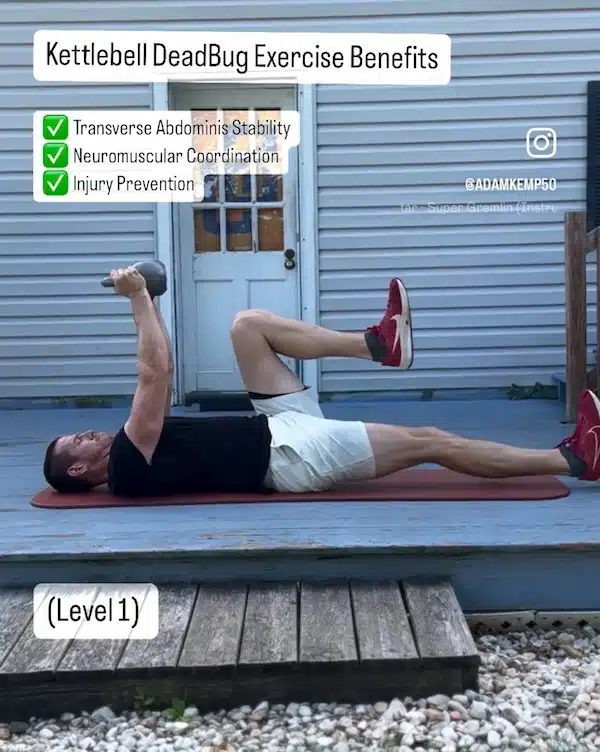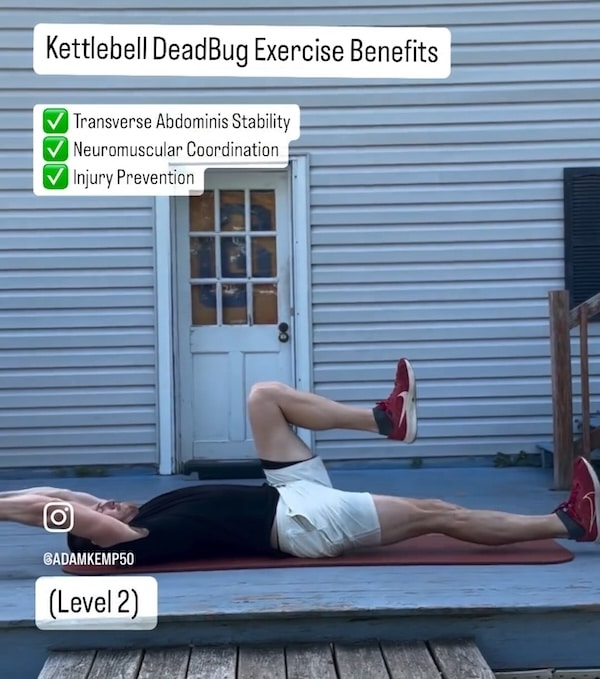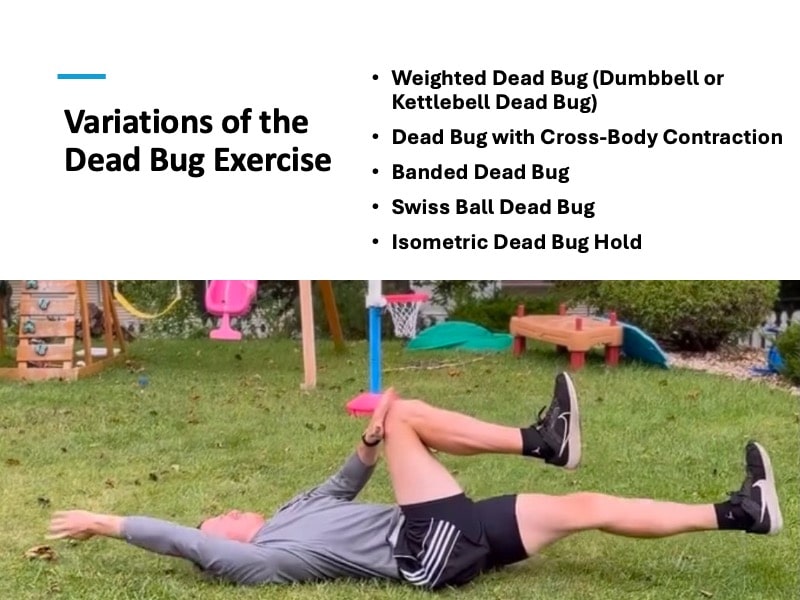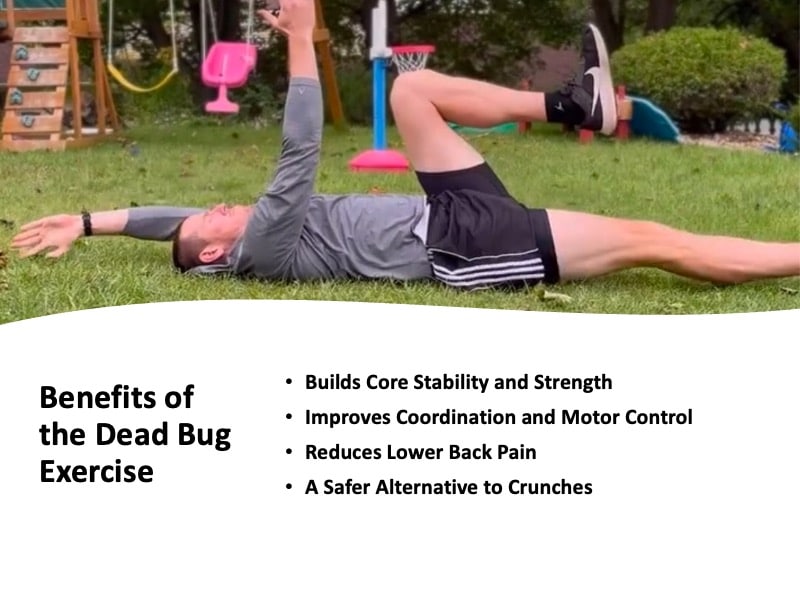Kettlebell Dead Bug: Benefits, How to Do, Muscles Worked
The kettlebell dead bug is a highly effective core exercise that goes beyond typical abdominal workouts, targeting core stability, strength, and control.
The kettlebell deadbug trains spinal stability, neuromuscular control, and total-body coordination, and unlike typical ab workouts that focus solely on aesthetics, this movement develops true core integrity for athletes and active individuals.
As a professional basketball player who plays the center position, maintaining a strong and stable core is crucial for preventing injuries on the court, particularly in the lower back and hips.
The kettlebell dead bug directly addresses this need by engaging deep core muscles like the transverse abdominis and obliques, which are essential for maintaining spine stability during dynamic movements such as jumping, pivoting, and absorbing contact in the paint.
In addition to core strength, the KB deadbug exercise plays a significant role in improving shoulder strength and stability.
For athletes like myself, who rely on upper body strength for rebounding, blocking shots, and executing powerful post moves, the overhead extension in the kettlebell dead bug provides targeted engagement of the shoulders and lats.
This not only helps to prevent shoulder injuries but also improves overhead mobility, which is critical for optimal performance in basketball and other sports that demand upper body control.
Whether you’re an athlete looking to optimize performance or a fitness enthusiast seeking a safe and effective core stability exercise, the kettlebell dead bug belongs in your routine, and it is one of the best kettlebell ab exercises for developing foundational strength and long-term durability.
What Is the KB Deadbug Exercise?
The KB deadbug, short for kettlebell dead bug, is an advanced variation of the classic dead bug exercise that utilizes a kettlebell for added resistance and neuromuscular demand.
This movement challenges core stability by forcing your body to resist movement and maintain alignment while coordinating opposite-arm and leg extensions.
Adding a kettlebell amplifies the challenge by increasing the load on your shoulders and midsection, promoting deeper engagement of your transverse abdominis, obliques, and hip flexors.
In the dead bug exercise with kettlebell, you lie on your back, hold a kettlebell above your chest (or extend it overhead), and perform controlled movements of your limbs while keeping your spine neutral and core braced.
The kettlebell acts as both a resistance tool and a stability challenge, making the kettlebell deadbug ideal for improving athletic control, motor coordination, and anti-extension core strength.
This movement is often used in injury prevention programs, functional strength routines, and sports performance training, and it’s one of the most effective core exercises with a kettlebell because it recruits stabilizers in both the upper and lower body simultaneously.
Kettlebell Dead Bug Muscles Worked
The kettlebell dead bug is a compound, anti-extension core exercise that activates several muscle groups across the anterior and posterior chain.
Here’s a breakdown of the primary muscles engaged during the movement:
Core Muscles
The dead bug exercise primarily activates the transversus abdominis, internal obliques, rectus abdominis, and lumbar multifidus, creating a stable core foundation that supports efficient movement and reduces injury risk (Tsartsapakis et al., 2024).
The kettlebell dead bug increases activation demands on these core stabilizers by introducing external load and shoulder engagement, further enhancing anti-extension control and neuromuscular coordination.
- Transverse Abdominis: Acts as the body’s internal weight belt, stabilizing the spine and pelvis throughout the movement.
- Rectus Abdominis: Assists in trunk flexion and resists excessive lumbar extension.
- Internal & External Obliques: Control rotational stability and coordinate contralateral arm-leg movement.
- Multifidus & Other Deep Stabilizers: Support segmental spinal stability during limb movement.
Shoulders
- Anterior Deltoids & Rotator Cuff Muscles (supraspinatus, infraspinatus, teres minor, subscapularis): Stabilize the shoulder joint, especially in the overhead kettlebell dead bug variation (Level 2), where load control is critical.
Latissimus Dorsi (Lats):
- Engaged during the overhead extension phase, helping control the kettlebell’s arc while maintaining scapular stability and spinal alignment.
Hip Flexors:
- Iliopsoas and Rectus Femoris: Activated as the legs lower and return, coordinating movement with the core and resisting anterior pelvic tilt.
This integrated muscular activation makes the dead bug with kettlebell a highly effective exercise for improving kinetic chain function, postural control, and athletic resilience.
How to Do the KB Dead Bug
There are two levels of kettlebell dead bugs to start with, each progressively more challenging.
First, mastering the bodyweight dead bug exercise is important to building a solid foundation.
Once you have good control and stability, you can progress to Level 1, where you hold the kettlebell above your chest, and then advance to Level 2, which incorporates an overhead extension for added difficulty.
Level 1: Kettlebell Dead Bug (KB Iso-Hold)

- Setup: Lie flat on your back with your knees bent at a 90-degree angle, directly above your hips. Hold a kettlebell with both hands, arms extended straight above your chest.
- Engage Your Core: Press your lower back into the floor and engage your core muscles.
- Perform the Dead Bug: Slowly lower your right arm and left leg towards the floor, keeping the kettlebell steady above your chest. The arm holding the kettlebell should not move.
- Return to Start: Bring your arm and leg back to the starting position, keeping the kettlebell stable. Repeat on the opposite side.
- Repetitions: Perform 8-12 repetitions on each side, maintaining control and focus on your core throughout.
Level 2: Kettlebell Dead Bug with Overhead Extension

- Setup: Start in the same position as Level 1, lying on your back with your knees bent at 90 degrees and holding the kettlebell above your chest.
- Engage Your Core: Ensure your lower back is pressed into the floor and your core is engaged.
- Perform the Dead Bug with Overhead Extension: As you lower your right arm and left leg towards the floor, simultaneously lower the kettlebell in a controlled arc behind your head until it almost touches the ground.
- Return to Start: Bring your arm and leg back to the starting position while raising the kettlebell back above your chest. Repeat on the opposite side.
- Repetitions: Perform 6-10 repetitions on each side, focusing on slow, controlled movements.
KB Deadbug Safety Tips
- Maintain a Neutral Spine: Always keep your lower back pressed into the floor to avoid arching, which can strain the lumbar spine.
- Control the Movement: Avoid rushing through the exercise. Focus on slow, controlled movements to maximize muscle engagement and reduce the risk of injury.
- Start Light: Begin with a lighter kettlebell and gradually increase the weight as you become more comfortable with the movement.
- Breathe: Exhale during the effort phase (lifting the kettlebell or extending the legs) and inhale during the relaxation phase to maintain stability and control.
Progressions and Regressions for the Kettlebell Dead Bug

Progressions
- Increase Kettlebell Weight: Gradually increase the weight of the kettlebell to add more resistance and challenge your core stability further.
- Add Leg Extensions: Extend the legs fully instead of keeping them bent during the dead bug motion to increase the difficulty.
- Combine with Other Core Movements: Integrate the kettlebell dead bug into a circuit with other core exercises, such as planks or Russian twists, for a more comprehensive workout.
Regressions

- Reduce Kettlebell Weight: If holding the kettlebell becomes too challenging, use a lighter weight or perform the exercise without any weight until you build sufficient strength.
- Bend the Knees: Perform the dead bug exercise with bent knees instead of fully extending your legs to reduce the strain on the lower back and make the exercise more manageable.
- Perform Only Arm or Leg Movements: Isolate either the arm or leg movement if coordinating both at once proves too difficult.
How Often Should You Do the KB Deadbug Exercise?
You can safely incorporate the kb dead bug into your routine 2 to 4 times per week, depending on your training goals and recovery capacity.
For athletes and active individuals, performing the kettlebell dead bug as part of a warm-up or core activation sequence before strength training or skill work helps prime the core for stability and movement efficiency.
When used post-workout or during off days, it reinforces motor control without overstressing the nervous system.
Because the dead bug with kettlebell targets deep stabilizers and does not create significant muscle breakdown, it can be trained frequently, as long as technique and movement quality remain your focus.
However, you should progress slowly with load and complexity to avoid compensation patterns and overuse.
Integrating kettlebell deadbugs consistently improves core endurance, trunk stiffness, and control, all of which contribute to better performance and reduced injury risk over time.
Benefits of the Kettlebell Dead Bug
The kettlebell dead bug is more than just a core exercise, it’s a total-body stability drill that develops movement control, builds functional strength, and protects against injury.
Whether your goal is to get six-pack abs, improve posture, or improve general core strength, the KB dead bug offers a safer and more efficient alternative to crunches and situps for developing your core.
Better Core Stability
The kettlebell dead bug targets deep core stabilizers like the transverse abdominis and internal obliques, which are essential for maintaining spinal alignment during dynamic movement.
This makes it a go-to exercise for athletes, lifters, and anyone needing more trunk control and core endurance.
Improved Neuromuscular Coordination
Executing the kb deadbug requires precise limb control while resisting spinal movement, improving communication between your brain and muscles.
This neuromuscular training carries over to better movement mechanics in sports, lifting, and everyday activities like running or climbing stairs.
Injury Prevention
Core dysfunction is a common contributor to chronic back pain and movement compensations.
The dead bug exercise with kettlebell reinforces proper movement patterns while strengthening muscles that stabilize the pelvis and lumbar spine, significantly lowering the risk of overuse injuries.
Shoulder and Lat Engagement
In the advanced variation where the kettlebell is extended overhead, the kettlebell deadbug also strengthens the deltoids, lats, and rotator cuff muscles.
This promotes shoulder joint stability and can improve the overhead range of motion, which is key for athletes in sports like basketball, volleyball, or swimming.



